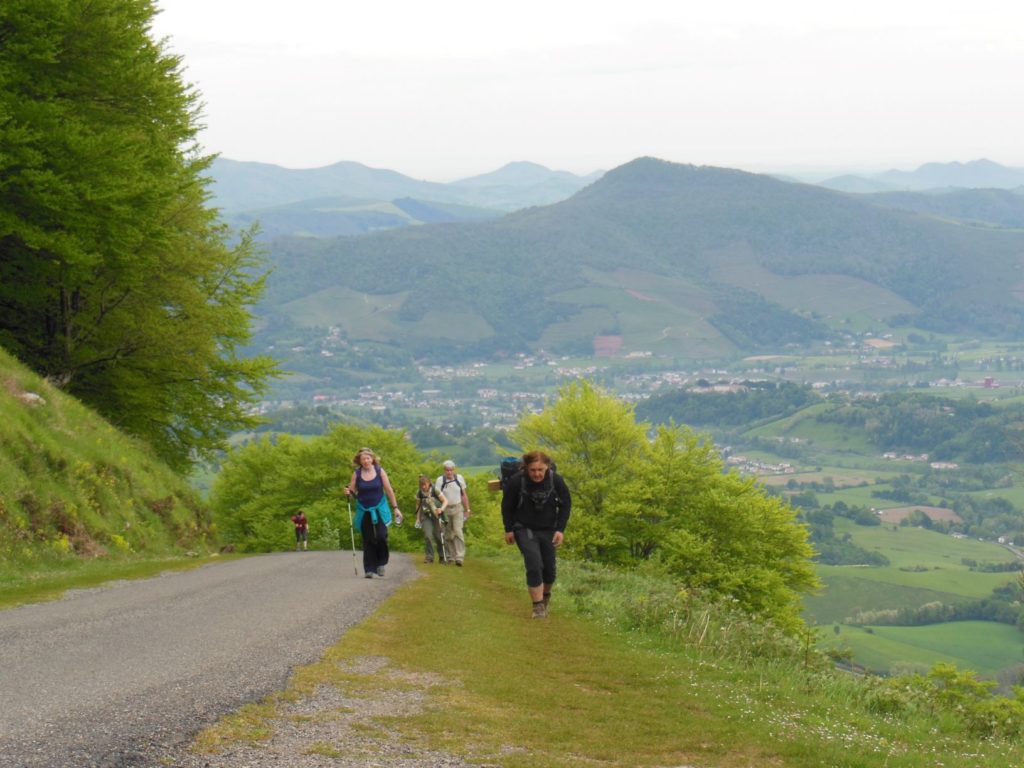These pilgrims are on the first day of their Camino. They think this is the hardest day. They think that if they can do this ridiculously grueling day, they’ll be in good shape. They’re almost certainly wrong.
The first day of the Camino de Santiago Francés is about 15 miles long, an average day on the Camino. That’s hard enough for new pilgrims. What makes it especially hard is the vertical gain followed by an equally steep downhill, over the Pyrenees from France into Spain.
My husband and I walked the Camino’s 500 miles across northern Spain to Santiago de Compostela in 37 days, averaging 13 miles daily. As many pilgrims do, we started our Camino in St. Jean Pied de Port at the foot of the French Pyrenees. We walked up and up and up and up, all day, to Col de Lepoeder, the top of the pass through the Pyrenees, a vertical gain of more than a mile, then down the other side.
Jed and I, being Oregonians and used to mountains, didn’t find the uphill particularly difficult. It was the downhill that got me. By the time we arrived at the Roncesvalles albergue (albergues are special hostels for pilgrims in Spain), my feet and ankles were in agony. I took off my boots to find bumps, bruises, and blisters that persisted for the entire 37 days we walked, and for months after.
Some pilgrims choose to skip this traditional hazing ritual, and start instead in Roncesvalles on the Spanish side of the Pyrenees. (Or in Pamplona, as the heroine of my novel does.)
I knew the first day would be hard. I knew what to expect. I thought that making it across the Pyrenees in one (admittedly bruised and battered) piece meant I had this thing licked and it was all smooth sailing from here. I was definitely wrong.
Why?
It’s a thing Seth Godin calls “the Dip” in his book of the same name. Teachers call it the “messy middle.” Wayfinder Life Coaches know it as “Square Three.”
The basic principle is this: anything worth doing becomes muddled and hard at some point. This is “the Dip.” There comes a point where the first blush of enthusiasm has worn off, the goal is still a very long way ahead, and the journey becomes a slog. This is when people quit.
Let me say that again: any important goal, anything worth doing—education, relationships, parenthood, your dream job, learning to play the guitar, walking 500 miles across Spain—gets hard at some point.
The first day of the Camino was ridiculous. The first week continued to be physically gruelling, but walking The Way of St. James was still fresh, new, and interesting. I still felt enthusiastic about this bananas thing we were doing.
But Day 10? Well. By then I was tired of suffering for no apparent purpose. Tired of sleeping in communal dorms and washing in communal showers and walking on bruised and blistered feet for miles every day. I had lost my enthusiasm.
Most pilgrims who quit the Camino don’t do it in the first week. No. They quit in the middle. They hit the Dip and they don’t have the resources to keep going. (This is why the Camino is a pilgrimage, not just a nice walk in the Spanish countryside. You meet yourself—who you really are and what you really want—on the Camino.)
The Dip is when you decide if this thing you committed to doing is really something you want to do. The Dip is when you choose, or not, to keep putting one foot in front of the other because the destination waiting for you at the other end is so amazing that it’s worth this suffering.
The Camino de Santiago Francés is 500 miles long. Most pilgrims take 30 to 40 days. That leaves a long time in the middle where it really is just putting one foot in front of the other, because Santiago is still hundreds of miles down a very dusty road.
The goal seems unreachable. What you’re doing seems loco. I mean, come on. Really? Walking somewhere when you could drive it in one really long day? What’s up with that? It’s crazy. You’re tired. You’re dirty. You’re sore. It’s just not a rational thing to do.
Many of the things we deeply want to do aren’t rational.
The Dip is real. Know it’s coming. Expect it. Prepare for it. Make a plan to navigate it. If you know you don’t have the resources to get through the Dip, don’t start.
This is the choice I had to make. Walking the Camino for Jed wasn’t going to cut it. I had to do it for me, or not do it at all. I had to walk my own walk, or not walk at all. I was going to end up hating my husband if I continued suffering for him. I had to choose the Dip. I had to commit to MY Camino. I had to say, “I’m doing this, for me.”
What got me through the Dip? My husband’s dogged determination. Companions on the Way. The hard-core mystical energy of a path that’s been trodden by prayerful, strong people for a thousand years. My coaching skills and practice working with my thoughts. Walking one day at a time and celebrating my progress, slow as it felt. Marking intermediate milestones: Pamplona, Burgos, León, El Cruz de Ferro, every mountain pass. Two experiences of the Holy that told me I was where I needed to be.
Is there something you want to do? Be ready for the Dip. Plan for it. Assess your resources and marshal your reserves. Ask for help navigating the Dip. If that help might be me, check out my new “Get Your Thing Done” coaching package here. I’d love to connect.
PS. If you’ve read this far, you’re a dedicated blog-follower. I’d love it if you’d subscribe to my newsletter, which will soon replace this blog completely.
Photo credit: Jed Holdorph, 6 May 2014


